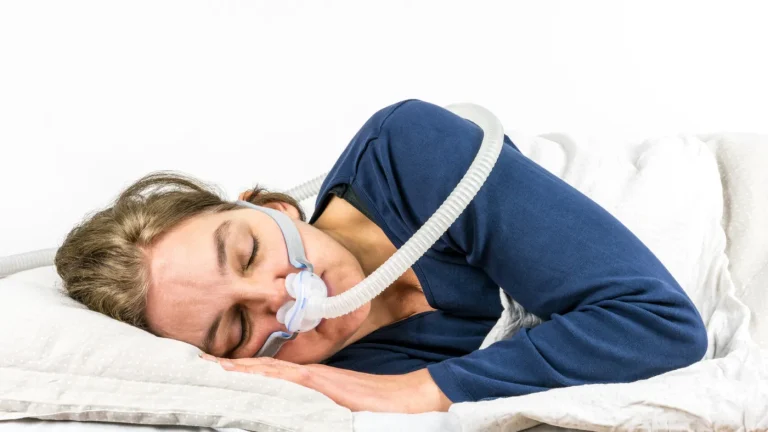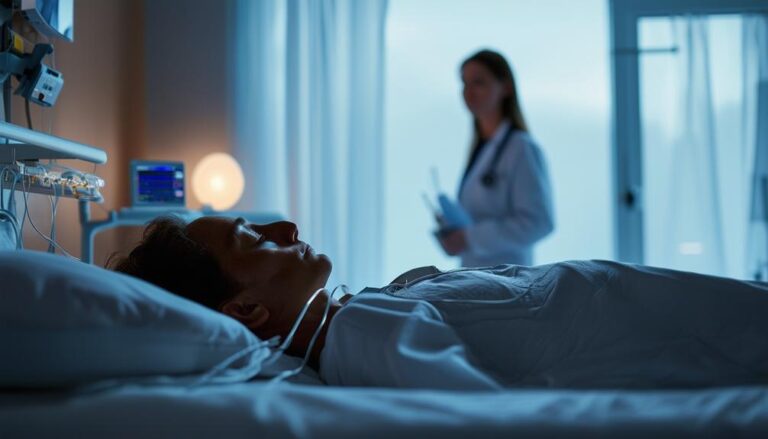Sleep Apnea Screening Test
A sleep apnea screening test, such as the STOP-Bang Questionnaire, identifies risk factors for obstructive sleep apnea (OSA). You'll answer questions about snoring, fatigue, and comorbidities like hypertension. Key measurements include BMI, neck circumference, and age. Loud snoring, daytime sleepiness, and observed breathing cessation are primary symptoms. Early detection through screening can reduce health risks and improve your sleep quality. Consistently high scores on these questionnaires indicate a higher risk for OSA and necessitate further medical evaluation. Learning about screening tools and processes will help you understand how to manage potential risks effectively.
Noteworthy Details
- The STOP-Bang Questionnaire is a widely used screening tool for obstructive sleep apnea.
- Key risk factors assessed include snoring, BMI, hypertension, age, and neck circumference.
- Early screening can prevent severe complications and improve patient outcomes.
- Loud snoring and daytime sleepiness are significant symptoms indicating the need for screening.
- Measuring neck circumference can help in identifying individuals at higher risk.
Prevalence and Incidence
Obstructive Sleep Apnea (OSA) affects approximately 1 billion adults globally, with a significant majority of moderate to severe cases remaining undiagnosed. The prevalence of OSA is significantly higher in men compared to women, and the occurrence of this condition increases with age. This widespread disorder doesn't discriminate, impacting all ethnic groups. Given these statistics, it's essential to understand the risk factors associated with OSA and employ effective screening methods to identify those at risk.
One widely used tool in screening for OSA is the STOP Questionnaire. This evidence-based instrument assesses key risk factors such as Snoring, Tiredness during daytime, Observed apneas, and high blood Pressure. By answering a few targeted questions, you can gauge your risk for OSA and determine whether further clinical evaluation is necessary.
Understanding the prevalence and occurrence of OSA is vital for healthcare providers and individuals alike. Early identification through tools like the STOP Questionnaire can help mitigate the burden of undiagnosed OSA, reducing associated health risks. By actively engaging in screening, you contribute to better health outcomes and a higher quality of life.
Symptoms and Signs
When screening for sleep apnea, you should be aware of several critical symptoms and signs.
Loud snoring, observed episodes of breathing cessation, and significant daytime sleepiness often indicate obstructive sleep apnea (OSA).
Additionally, morning headaches and difficulties with concentration or irritability can further corroborate the diagnosis.
Common OSA Symptoms
Loud snoring, daytime fatigue, and observed breathing pauses during sleep are hallmark symptoms of obstructive sleep apnea (OSA).
If you frequently find yourself excessively sleepy during the day, you might be experiencing daytime sleepiness, a significant indicator of OSA.
Loud snoring, often noted by bed partners, suggests airway obstruction, a common characteristic of OSA. These breathing interruptions, or apneas, can be alarming and are typically observed by others while you sleep.
Morning headaches and persistent irritability are additional symptoms you shouldn't overlook. These signs result from the repeated drops in blood oxygen levels that occur during apneas.
Difficulty concentrating and memory problems are also frequent complaints among those with untreated OSA, likely due to fragmented sleep and insufficient restorative sleep stages.
You might also experience gasping or choking sensations during sleep, further disrupting your rest.
OSA is more common in men, and its likelihood increases with age. Untreated OSA doesn't just affect your sleep; it's linked with serious health conditions like hypertension, cardiovascular diseases, diabetes, and obesity.
Recognizing these symptoms early can lead to a proper diagnosis and effective management, improving overall health and quality of life.
Recognizing Daytime Sleepiness
Experiencing persistent daytime sleepiness, a prominent symptom of obstructive sleep apnea, can impair your daily functioning and overall quality of life to a significant extent. Daytime sleepiness is often characterized by excessive fatigue, difficulty staying awake during daytime activities, and an overwhelming urge to nap, even after a full night's sleep.
Recognizing this symptom is essential for identifying potential OSA risk factors. Daytime sleepiness can manifest in various ways, impacting your ability to concentrate, making you more irritable, and reducing your overall cognitive performance. These disruptions can greatly affect your professional and personal life, leading to mistakes at work, strained relationships, and a reduced capacity to enjoy daily activities.
Here's a table to help you visualize the potential impact and signs of daytime sleepiness related to OSA:
| Symptom | Description | Impact on Daily Life |
|---|---|---|
| Excessive Fatigue | Persistent tiredness despite adequate sleep | Reduced productivity |
| Difficulty Staying Awake | Trouble maintaining wakefulness during the day | Prone to accidents and errors |
| Decreased Concentration | Difficulty focusing and maintaining attention | Impaired cognitive performance |
Morning Headache Indicators
Morning headaches, often linked to untreated obstructive sleep apnea (OSA), can signal oxygen deprivation during sleep, necessitating clinical evaluation. When you experience these headaches, it's important to understand that they might stem from the brain's response to low oxygen levels throughout the night. This oxygen deprivation can lead to vasodilation and increased intracranial pressure, causing you to wake up with a headache.
Untreated obstructive sleep apnea disrupts your sleep architecture, leading to fragmented sleep and frequent arousals. These disruptions mean your body isn't getting the restorative sleep it needs, compounding the effects of oxygen deprivation. Morning headaches aren't just a minor inconvenience; they can greatly impact your daily functioning and overall quality of life. You might find it harder to concentrate, perform daily tasks, or even maintain a positive mood.
Monitoring morning headaches can be crucial in the early detection and management of OSA. If you're frequently waking up with headaches, it's a strong indicator that you should seek a professional evaluation for sleep apnea. Early diagnosis and treatment can alleviate these symptoms, enhancing your sleep quality and overall health.
Comorbidities
When evaluating patients for sleep apnea, it's important to recognize the significant influence of comorbidities such as hypertension, cardiovascular diseases, and diabetes. Obstructive Sleep Apnea (OSA) often coexists with these conditions, exacerbating their severity and complicating treatment. High blood pressure, for instance, is not just a risk factor but also a consequence of untreated OSA, leading to a vicious cycle that impairs cardiovascular health.
Addressing comorbidities is essential in the thorough management of sleep apnea. By effectively managing these interconnected health issues, you can markedly improve overall health outcomes and enhance quality of life. Evidence shows that treating sleep apnea can lead to better control of high blood pressure, reduced risk of stroke, and improved metabolic function.
Here's how untreated sleep apnea impacts various comorbidities:
| Comorbidity | Impact of Untreated OSA | Emotional Toll |
|---|---|---|
| Hypertension | Increased blood pressure levels | Constant concern about heart health |
| Cardiovascular Diseases | Elevated risk of heart failure and stroke | Fear of life-threatening events |
| Diabetes | Poor glucose control, increased insulin resistance | Anxiety over blood sugar levels |
Screening Tools
Screening tools like the STOP-Bang questionnaire and the Epworth Sleepiness Scale are vital for identifying individuals at risk of obstructive sleep apnea before they undergo diagnostic tests. These evidence-based tools evaluate symptoms such as snoring, daytime sleepiness, high blood pressure, and body mass index (BMI).
The STOP-Bang Questionnaire consists of 8 targeted questions designed to assess the likelihood of sleep apnea, focusing on key factors like neck circumference and observed apneas.
The Epworth Sleepiness Scale, on the other hand, quantifies daytime sleepiness through a series of questions about your propensity to fall asleep in different situations. This scale helps gauge the severity of your sleepiness, which can be an important indicator of sleep apnea.
Utilizing these screening tools in clinical practice allows healthcare providers to stratify patients effectively, ensuring those at higher risk are prioritized for further diagnostic testing, such as polysomnography.
STOP-Bang Questionnaire
The STOP-Bang survey, a widely recognized screening tool, evaluates your risk for obstructive sleep apnea through eight targeted inquiries covering key clinical risk factors. This tool assesses your likelihood of having obstructive sleep apnea by asking about snoring, daytime fatigue, observed breathing pauses during sleep, high blood pressure, BMI, age, neck circumference, and gender.
Each question focuses on a specific risk factor linked to obstructive sleep apnea. For example, habitual noisy snoring and observed apneas are direct indicators of potential airway blockage during sleep. High blood pressure and increased BMI are significant clinical risk factors, while age and neck circumference further refine risk stratification. Gender also plays a role, as males are statistically at higher risk.
A higher total score on the STOP-Bang survey correlates with an increased risk of having obstructive sleep apnea. However, remember that the survey is a screening tool, not a diagnostic one.
It's crucial to consult a healthcare provider for a formal diagnosis and interpretation of your results. This ensures a thorough evaluation and appropriate management of any identified sleep-related health concerns.
Risk Assessment
When evaluating your risk for obstructive sleep apnea (OSA), consider factors such as neck size, BMI, age, and gender.
Identifying high-risk individuals early is essential, as conditions like high blood pressure and diabetes can worsen OSA.
Early detection through a structured screening process enables prompt intervention and reduces related health risks.
Factors Influencing OSA Risk
Understanding the factors that influence obstructive sleep apnea (OSA) risk is essential for effective risk assessment and early intervention. Key indicators such as snoring, daytime fatigue, and breathing interruptions during sleep strongly contribute to the risk for sleep apnea. High blood pressure and an elevated body mass index (BMI) are also notable risk factors. Age and gender play pivotal roles, with individuals aged 50 and older being more susceptible. Males, particularly those with neck circumferences over 17 inches, and females over 16 inches, are at a heightened risk.
The presence of multiple risk factors like snoring, obesity, and hypertension can significantly increase the likelihood of developing OSA. Addressing these factors through proper screening can lead to early detection and more effective management.
| Risk Factor | Description | Impact Level |
|---|---|---|
| Snoring | Frequent loud snoring | High |
| Elevated BMI | BMI indicating obesity | High |
| Hypertension | Consistently high blood pressure | Moderate to High |
| Age | 50 years and older | High |
| Neck Circumference | Males > 17 inches, Females > 16 inches | High |
| Gender | Male predisposition | High |
Identifying these risk factors and understanding their implications can notably enhance the efficacy of OSA risk assessments.
Identifying High-Risk Individuals
Identifying high-risk individuals for obstructive sleep apnea (OSA) often involves utilizing the STOP-Bang questionnaire, which evaluates key risk factors including snoring, tiredness, and elevated BMI. This evidence-based tool assesses eight critical components:
- Snoring
- Tiredness during daytime
- Observed apnea
- High blood Pressure
- Body Mass Index (BMI) greater than 35
- Age over 50
- Neck circumference exceeding 40 cm
- Male Gender
Each affirmative response increases the likelihood of OSA, thereby helping to stratify high-risk individuals.
The STOP-Bang questionnaire is a quick, efficient method to screen for obstructive sleep apnea in a clinical setting. A higher cumulative score correlates with an increased probability of OSA. For instance, a score of 5 or more suggests a significant risk and warrants further diagnostic evaluation.
While the questionnaire is an excellent preliminary tool, it doesn't substitute for professional medical advice. High-risk individuals identified through STOP-Bang should consult a healthcare provider for thorough assessment and management.
Incorporating the STOP-Bang questionnaire into routine health evaluations can help identify high-risk individuals early. This proactive approach guarantees those at risk receive timely intervention, potentially mitigating the long-term impacts of untreated obstructive sleep apnea.
Importance of Early Detection
Early detection of sleep apnea through thorough risk assessment is essential for preventing severe complications and enhancing patient outcomes. Screening can identify individuals at risk by evaluating specific factors such as snoring, fatigue, and high blood pressure. By utilizing risk assessment tools like the STOP-Bang questionnaire, you can efficiently screen for sleep apnea risk factors, allowing for timely intervention.
Addressing sleep apnea early is important because untreated cases can lead to serious health issues, including cardiovascular disease, stroke, and impaired cognitive function. When you identify sleep apnea risk factors early, you can initiate appropriate treatment plans, such as Continuous Positive Airway Pressure (CPAP) therapy or lifestyle modifications, greatly improving the patient's quality of life.
Moreover, early detection through proper screening helps reduce the overall impact on daily functioning. Patients often experience better sleep quality, increased daytime alertness, and a lower risk of accidents related to fatigue.
Doctor Consultation
After completing a sleep apnea screening test, it's crucial to consult with your healthcare provider to discuss the results and potential next steps. This consultation plays a significant role in confirming a diagnosis and developing a thorough management plan.
Here's what you can anticipate during your doctor consultation:
- Review Screening Results: Your healthcare provider will analyze the results of your screening test, identifying any signs of obstructive sleep apnea (OSA).
- Recommendation for a Sleep Study: If the screening indicates potential OSA, your provider may suggest a polysomnography or home sleep study. This detailed assessment evaluates the severity and specifics of your condition.
- Discuss Treatment Strategies: Depending on your diagnosis, your provider will outline different treatment approaches. These may involve Continuous Positive Airway Pressure (CPAP) therapy, lifestyle adjustments, or other medical interventions customized to your requirements.
- Follow-Up and Monitoring: Effective management of sleep apnea necessitates regular follow-up appointments. Your healthcare provider will track your progress and make necessary modifications to your treatment plan.
Engaging in this consultation guarantees that you receive an accurate diagnosis and a personalized treatment plan. Don't underestimate the significance of this step; it's crucial in reducing the health risks linked to untreated sleep apnea.
Benefits and Harms
Assessing the benefits and harms of sleep apnea screening involves weighing the potential improvement in sleep quality and breathing against the risks and side effects of subsequent treatments. Treating obstructive sleep apnea (OSA) with interventions like Continuous Positive Airway Pressure (CPAP) can enhance sleep quality and stabilize breathing patterns. However, the evidence on the benefits derived from screening-detected OSA cases remains limited.
Using tools such as the STOP Questionnaire and measuring neck circumference can help identify individuals at risk for OSA. Yet, the balance of benefits and harms is still unclear. While screening might lead to early detection and treatment, potential harms include side effects from CPAP therapy, like oral or nasal dryness, and discomfort from wearing the device during sleep.
Furthermore, studies haven't thoroughly evaluated the negative impacts or harms associated with OSA screening itself. Due to this lack of in-depth evidence, it remains uncertain whether the advantages of identifying and treating OSA through screening outweigh the potential risks.
Hence, it's important to carefully consider these factors when deciding on sleep apnea screening, ensuring that the benefits outweigh any potential harms.
Frequently Asked Questions
What Is Screening for Sleep Apnea?
Think of screening as a detective mission for your health. It assesses sleep apnea symptoms, identifies sleep apnea risk factors, and paves the way for sleep apnea treatment, ensuring you get the care you need.
What Is the Best Screening for Sleep Apnea?
For the best sleep apnea screening, consider home testing for convenience. An overnight study provides thorough data, while a clinical evaluation by a healthcare provider guarantees accurate diagnosis. Combining these methods yields the most reliable results.
How to Be Tested for Sleep Apnea?
You can get tested for sleep apnea through home testing, polysomnography options, or telemedicine consultations. Choose home testing for convenience, polysomnography for thorough results, and telemedicine consultations for expert guidance. Consult your healthcare provider for recommendations.
Can an Apple Watch Detect Sleep Apnea?
You can't rely on the Apple Watch for accurate sleep disorder detection. While its wearable technology tracks sleep patterns and heart rate, it's not designed for diagnosing sleep apnea. Consult a healthcare provider for proper diagnosis.
Conclusion
So, you've got sleep apnea. Congratulations! You now have an excuse for falling asleep in meetings.
But seriously, don't skip that STOP-Bang questionnaire. It's not just another checklist; it's your ticket to a life where you breathe properly at night.
Consult your doctor—it's not like they went to medical school for nothing.
Remember, screening can save you from a slew of comorbidities.
Or hey, keep snoring and keep your bed partner awake. Your call.



